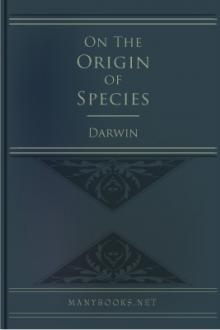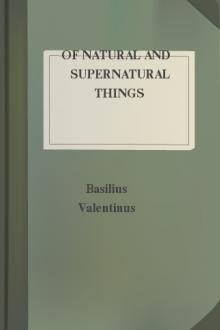The Origin of Species by means of Natural Selection (6th ed), Charles Darwin [the beginning after the end read novel .TXT] 📗

- Author: Charles Darwin
- Performer: -
Book online «The Origin of Species by means of Natural Selection (6th ed), Charles Darwin [the beginning after the end read novel .TXT] 📗». Author Charles Darwin
With these facts before me, I believe that natural selection, by acting on the fertile ants or parents, could form a species which should regularly produce neuters, all of large size with one form of jaw, or all of small size with widely different jaws; or lastly, and this is the greatest difficulty, one set of workers of one size and structure, and simultaneously another set of workers of a different size and structure; a graduated series having first been formed, as in the case of the driver ant, and then the extreme forms having been produced in greater and greater numbers, through the survival of the parents which generated them, until none with an intermediate structure were produced.
An analogous explanation has been given by Mr. Wallace, of the equally complex case, of certain Malayan butterflies regularly appearing under two or even three distinct female forms; and by Fritz Muller, of certain Brazilian crustaceans likewise appearing under two widely distinct male forms. But this subject need not here be discussed.
I have now explained how, I believe, the wonderful fact of two distinctly defined castes of sterile workers existing in the same nest, both widely different from each other and from their parents, has originated. We can see how useful their production may have been to a social community of ants, on the same principle that the division of labour is useful to civilised man. Ants, however, work by inherited instincts and by inherited organs or tools, while man works by acquired knowledge and manufactured instruments. But I must confess, that, with all my faith in natural selection, I should never have anticipated that this principle could have been efficient in so high a degree, had not the case of these neuter insects led me to this conclusion. I have, therefore, discussed this case, at some little but wholly insufficient length, in order to show the power of natural selection, and likewise because this is by far the most serious special difficulty which my theory has encountered. The case, also, is very interesting, as it proves that with animals, as with plants, any amount of modification may be effected by the accumulation of numerous, slight, spontaneous variations, which are in any way profitable, without exercise or habit having been brought into play. For peculiar habits, confined to the workers of sterile females, however long they might be followed, could not possibly affect the males and fertile females, which alone leave descendants. I am surprised that no one has advanced this demonstrative case of neuter insects, against the well-known doctrine of inherited habit, as advanced by Lamarck.
SUMMARY.
I have endeavoured in this chapter briefly to show that the mental qualities of our domestic animals vary, and that the variations are inherited. Still more briefly I have attempted to show that instincts vary slightly in a state of nature. No one will dispute that instincts are of the highest importance to each animal. Therefore, there is no real difficulty, under changing conditions of life, in natural selection accumulating to any extent slight modifications of instinct which are in any way useful. In many cases habit or use and disuse have probably come into play. I do not pretend that the facts given in this chapter strengthen in any great degree my theory; but none of the cases of difficulty, to the best of my judgment, annihilate it. On the other hand, the fact that instincts are not always absolutely perfect and are liable to mistakes; that no instinct can be shown to have been produced for the good of other animals, though animals take advantage of the instincts of others; that the canon in natural history, of “Natura non facit saltum,” is applicable to instincts as well as to corporeal structure, and is plainly explicable on the foregoing views, but is otherwise inexplicable—all tend to corroborate the theory of natural selection.
This theory is also strengthened by some few other facts in regard to instincts; as by that common case of closely allied, but distinct, species, when inhabiting distant parts of the world and living under considerably different conditions of life, yet often retaining nearly the same instincts. For instance, we can understand, on the principle of inheritance, how it is that the thrush of tropical South America lines its nest with mud, in the same peculiar manner as does our British thrush; how it is that the Hornbills of Africa and India have the same extraordinary instinct of plastering up and imprisoning the females in a hole in a tree, with only a small hole left in the plaster through which the males feed them and their young when hatched; how it is that the male wrens (Troglodytes) of North America, build “cock-nests,” to roost in, like the males of our Kitty-wrens,—a habit wholly unlike that of any other known bird. Finally, it may not be a logical deduction, but to my imagination it is far more satisfactory to look at such instincts as the young cuckoo ejecting its foster-brothers, ants making slaves, the larvae of ichneumonidae feeding within the live bodies of caterpillars, not as specially endowed or created instincts, but as small consequences of one general law leading to the advancement of all organic beings—namely, multiply, vary, let the strongest live and the weakest die.
CHAPTER IX.
HYBRIDISM.
Distinction between the sterility of first crosses and of hybrids —
Sterility various in degree, not universal, affected by close interbreeding, removed by domestication — Laws governing the sterility of hybrids — Sterility not a special endowment, but incidental on other differences, not accumulated by natural selection — Causes of the sterility of first crosses and of hybrids — Parallelism between the effects of changed conditions of life and of crossing — Dimorphism and trimorphism — Fertility of varieties when crossed and of their mongrel offspring not universal — Hybrids and mongrels compared independently of their fertility — Summary.
The view commonly entertained by naturalists is that species, when intercrossed, have been specially endowed with sterility, in order to prevent their confusion. This view certainly seems at first highly probable, for species living together could hardly have been kept distinct had they been capable of freely crossing. The subject is in many ways important for us, more especially as the sterility of species when first crossed, and that of their hybrid offspring, cannot have been acquired, as I shall show, by the preservation of successive profitable degrees of sterility. It is an incidental result of differences in the reproductive systems of the parent-species.
In treating this subject, two classes of facts, to a large extent fundamentally different, have generally been confounded; namely, the sterility of species when first crossed, and the sterility of the hybrids produced from them.
Pure species have of course their organs of reproduction in a perfect condition, yet when intercrossed they produce either few or no offspring.
Hybrids, on the other hand, have their reproductive organs functionally impotent, as may be clearly seen in the state of the male element in both plants and animals; though the formative organs themselves are perfect in structure, as far as the microscope reveals. In the first case the two sexual elements which go to form the embryo are perfect; in the second case they are either not at all developed, or are imperfectly developed. This distinction is important, when the cause of the sterility, which is common to the two cases, has to be considered. The distinction probably has been slurred over, owing to the sterility in both cases being looked on as a special endowment, beyond the province of our reasoning powers.
The fertility of varieties, that is of the forms known or believed to be descended from common parents, when crossed, and likewise the fertility of their mongrel offspring, is, with reference to my theory, of equal importance with the sterility of species; for it seems to make a broad and clear distinction between varieties and species.
DEGREES OF STERILITY.
First, for the sterility of species when crossed and of their hybrid offspring. It is impossible to study the several memoirs and works of those two conscientious and admirable observers, Kolreuter and Gartner, who almost devoted their lives to this subject, without being deeply impressed with the high generality of some degree of sterility. Kolreuter makes the rule universal; but then he cuts the knot, for in ten cases in which he found two forms, considered by most authors as distinct species, quite fertile together, he unhesitatingly ranks them as varieties. Gartner, also, makes the rule equally universal; and he disputes the entire fertility of Kolreuter’s ten cases. But in these and in many other cases, Gartner is obliged carefully to count the seeds, in order to show that there is any degree of sterility. He always compares the maximum number of seeds produced by two species when first crossed, and the maximum produced by their hybrid offspring, with the average number produced by both pure parent-species in a state of nature. But causes of serious error here intervene: a plant, to be hybridised, must be castrated, and, what is often more important, must be secluded in order to prevent pollen being brought to it by insects from other plants. Nearly all the plants experimented on by Gartner were potted, and were kept in a chamber in his house. That these processes are often injurious to the fertility of a plant cannot be doubted; for Gartner gives in his table about a score of cases of plants which he castrated, and artificially fertilised with their own pollen, and (excluding all cases such as the Leguminosae, in which there is an acknowledged difficulty in the manipulation) half of these twenty plants had their fertility in some degree impaired. Moreover, as Gartner repeatedly crossed some forms, such as the common red and blue pimpernels (Anagallis arvensis and coerulea), which the best botanists rank as varieties, and found them absolutely sterile, we may doubt whether many species are really so sterile, when intercrossed, as he believed.
It is certain, on the one hand, that the sterility of various species when crossed is so different in degree and graduates away so insensibly, and, on the other hand, that the fertility of pure species is so easily affected by various circumstances, that for all practical purposes it is most difficult to say where perfect fertility ends and sterility begins. I think no better evidence of this can be required than that the two most experienced observers who have ever lived, namely Kolreuter and Gartner, arrived at diametrically opposite conclusions in regard to some of the very same forms. It is also most instructive to compare—but I have not space here to enter on details—the evidence advanced by our best botanists on the question whether certain doubtful forms should be ranked as species or varieties, with the evidence from fertility adduced by different hybridisers, or by the same observer from experiments made during different years. It can thus be shown that neither sterility nor fertility affords any certain distinction between species and varieties. The evidence from this source graduates away, and is doubtful in the same degree as is the evidence derived





Comments (0)